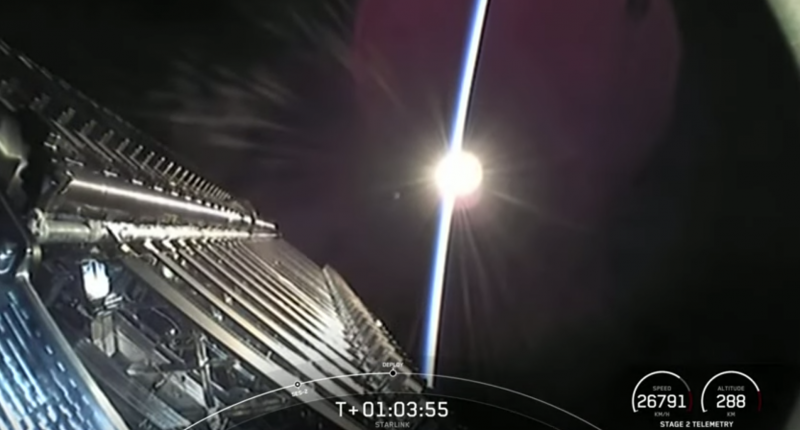NASA, Amazon, Satellite Operators Take Issue with SpaceX Starlink Gen-2 in FCC Filings

Starlink satellites before deployment on SpaceX’s March 24 Falcon 9 mission. Screenshot via SpaceX.
A number of satellite operators and NASA submitted comments to the FCC this week, taking issue with SpaceX’s proposed modifications to its second generation Starlink constellation (Gen2).
SES, Viasat, OneWeb, and Amazon all submitted comments on SpaceX’s proposed Gen2 system of nearly 30,000 additional satellites in its Low-Earth Orbit (LEO) broadband constellation. The FCC has not approved SpaceX’s plan. The operators’ and NASA’s concerns followed similar lines, including spectrum sharing and interference, risk of collision, and post-mission disposal.
NASA said it anticipates its science missions and human spaceflight operations would see an increase in conjunctions with Gen2, which would increase the number of objects below 600 km over five-fold. SpaceX has said that there is zero risk of Starlink collision with large objects because each spacecraft can maneuver, but NASA said that estimate “lacks statistical substantiation.”
“With the potential for multiple constellations with thousands and tens of thousands of spacecraft, it is not recommended to assume propulsion systems, ground detection systems, and software are 100% reliable, or that manual operations (if any) are 100% error-free,” wrote Samantha Fonder, NASA representative to the Commercial Space Transportation Interagency Group.
NASA expressed concerns with auto-maneuver capability and situations in which multiple constellations are auto-maneuvering without clearly defined rules. The agency recommends that SpaceX commission a risk analysis for autonomous versus autonomous constellation conjunction assessments and mitigation actions.
NASA also shared concerns about sun glint from Starlink satellites affecting Earth observation missions, including the Hubble Space Telescope, and Starlink interference in asteroid survey images for planetary defense.
OneWeb, which has a competing constellation in LEO, said that a constellation of Gen2’s proposed size proposes a unique risk to other operators for spectrum access. OneWeb argued that the FCC’s spectrum sharing and orbital resource rules have not kept up with Non-Geostationary Orbit (NGSO) developments in recent years, and NGSO operators do not agree on how to interpret the current rules and how the rules should be revised.
“While it is possible for large NGSO systems to be spectrally efficient by capitalizing on satellite diversity, it is also very likely that the operator with the largest system will significantly impair other smaller NGSO FSS [fixed satellite service] systems by exploiting the lack of adequate information to apply the current band-splitting rule. At this time, every other NGSO FSS system is significantly smaller than SpaceX and is appreciably disadvantaged with regard to spectrum splitting and orbital debris mitigation as a direct result,” OneWeb said.
Viasat, which operates satellites in Geostationary Orbit (GEO), and has fought changes to the Starlink system, continues to ask for an environmental impact statement on the constellation. In this week’s filing, Viasat asked for an orbital debris mitigation plan addressing all of the collision risks for the expanded Starlink system, and for the FCC to decline SpaceX’s application until the company gives more information on the risks of the system.
“SpaceX’s proposed expansion would foreclose competition, preclude other valuable uses of scarce and shared spectrum and orbital resources, pose an unacceptable risk of interference, and endanger both orbital safety and the human environment,” Viasat said.
The operator also took issue at SpaceX’s proposed expansion due to questions about the current system.
“SpaceX has not yet offered mass-market service or demonstrated that it is capable of delivering the promised benefits that formed the basis for the commission’s authorization,” Viasat said. “There is little basis for the commission or any other party to evaluate how the Starlink system actually performs under real-world conditions… or whether the operation of the Starlink system under real-world conditions actually serves the public interest.”
These comments on SpaceX’s application come after the company said this week it could lose up to 40 satellites from the most recent Starlink launch due to a geomagnetic storm in space that increased atmospheric drag.